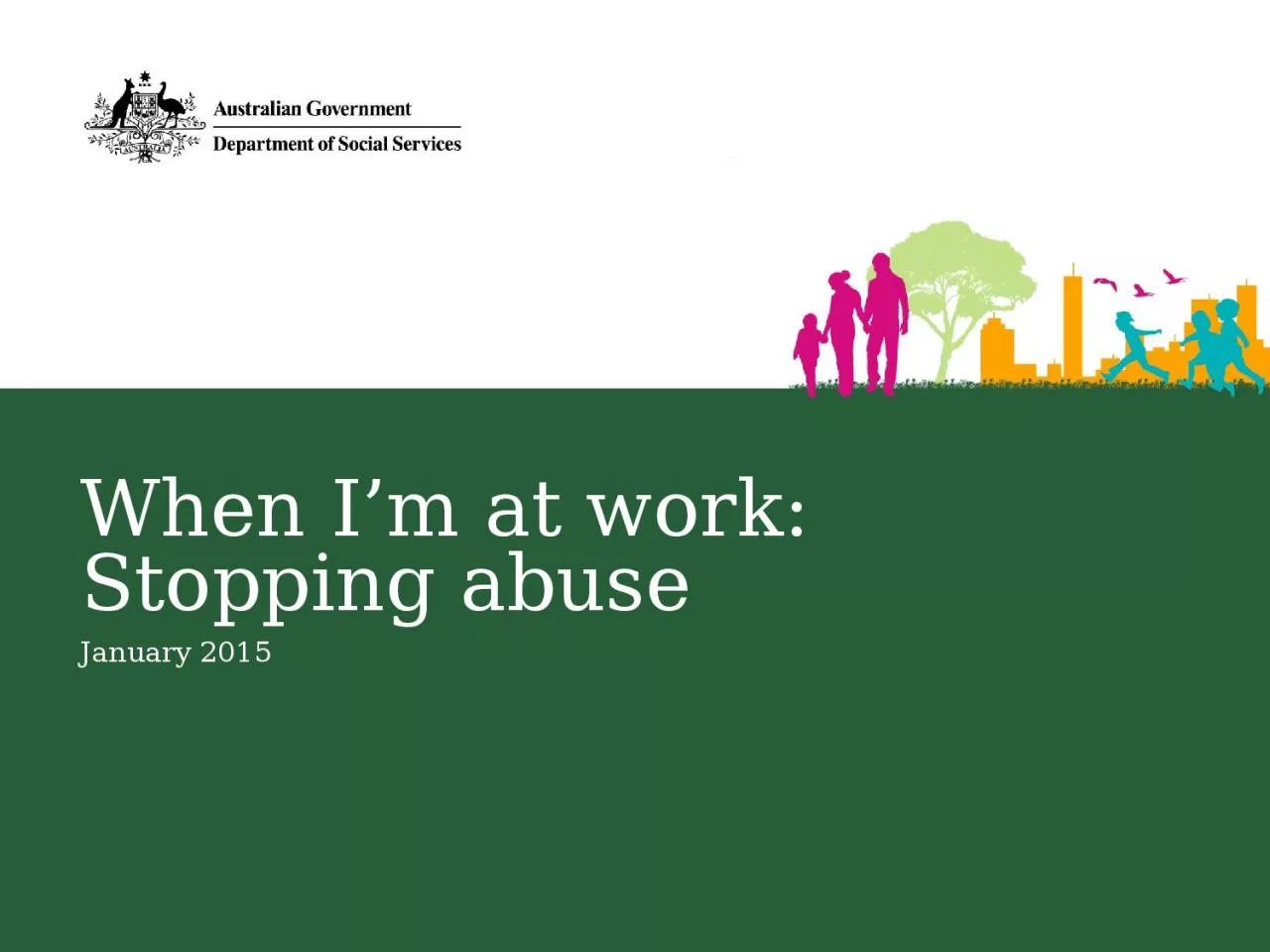

January 2015 What are your human rights Live without fear Feel safe where you live Enjoy the same rights as other people do Make your own decisions about things Get help and a fair go if you are in trouble ID: 1002934
Download Presentation The PPT/PDF document "When I’m at work: Stopping abuse" is the property of its rightful owner. Permission is granted to download and print the materials on this web site for personal, non-commercial use only, and to display it on your personal computer provided you do not modify the materials and that you retain all copyright notices contained in the materials. By downloading content from our website, you accept the terms of this agreement.
1. When I’m at work:Stopping abuseJanuary 2015
2. What are your human rights?Live without fear.Feel safe where you live.Enjoy the same rights as other people do.Make your own decisions about things.Get help and a fair go if you are in trouble.Work where and when you choose.When I’m at work: Stopping abuse2
3. What is abuse?… when another person harms or hurts you in some way …When I’m at work: Stopping abuse3
4. Physical abusePhysical abuse is when someone hurts you by touching you, for example, by: punching you hitting you slapping you burning you.When I’m at work: Stopping abuse4
5. Emotional abuseEmotional abuse is when someone hurts your feelings or makes you upset. It can include: calling you names telling you things to make you frightened.When I’m at work: Stopping abuse5
6. Sexual abuseSexual abuse includes being: touched on your private parts when you have not said it is okay forced to have sex when you do not want to.When I’m at work: Stopping abuse6
7. Chemical abuseChemical abuse includes being forced to take medication (tablets or injections),or illegal drugs, when you do not want to.When I’m at work: Stopping abuse7
8. Financial abuseExamples of financial abuse include other people taking your: money personal things and using them without asking you first.When I’m at work: Stopping abuse8
9. Verbal abuseVerbal abuse includes someone saying things about you that are not true.It could also be someone saying nasty things about what you say or do.When I’m at work: Stopping abuse9
10. Civil or legal abuseCivil or legal abuse includes not being allowed to:use your rights as a citizen, for example, not being allowed to vote (if you are an adult citizen of Australia)speak for yourself, or to choose who will speak for you if you have to go to court.When I’m at work: Stopping abuse10
11. Abuse in the workplaceYou could be abused by:your co-workerssupervisorssupport staffmanagersanyone at work.When I’m at work: Stopping abuse11Workplace abuse can be: physical financial verbal sexual chemical emotional.
12. What can you do about abuse?Tell someone who you trust.This is called reporting the abuse.When I’m at work: Stopping abuse12
13. Reporting abuse outside workTell a family member, support worker, friend, member of your church, or the police.Remember to tell: what is happening why you think you are being abused when it is happening who is abusing you.When I’m at work: Stopping abuse13
14. What can you expect to happen?When you report abuse, people you tell should:listen to youdo something quicklytell you what they will do to help you, and how long it will takelet you know about what’s happening with your complaint.When I’m at work: Stopping abuse14
15. What if nothing changes?If you tell someone but they do not do anything about it, do not give up.Tell someone else.When I’m at work: Stopping abuse15
16. Reporting abuse at workYour workplace must protect you from abuse.The National Standards for Disability Services make that clear.When I’m at work: Stopping abuse16
17. Standard 1: RightsStandard 1 is about the protection of human rights.When you are at work, your workplace must: make sure you are safe and treated fairly stand up for your rights.Nobody should: hurt you talk to you in a way that you do not like treat you badly because of your disability.When I’m at work: Stopping abuse17
18. Your workplace’s complaints policyTells you how to make a formal complaint.Your supervisor can help you with this.It is your right to use the complaints policy if you need to.When I’m at work: Stopping abuse18
19. Other ways to make a complaintSometimes, the people you rely on for help can also be the people who abuse you.Your workplace can give you details about how to contact an advocacy or complaints service.People there can help you as well.When I’m at work: Stopping abuse19
20. Remember your human rights!It is really important to remember that abuse harms you in all sorts of ways, not just physically.If someone who should be looking after you is not doing so, they are taking away your human rights and you should tell someone it is happening.When I’m at work: Stopping abuse20
21. Who can help you stop the abuse?If you are in danger, call the police on 000.The fact sheet about stopping abuse has further contact details.When I’m at work: Stopping abuse21
22. National Disability Abuse and Neglect HotlinePeople at the Hotline can help you. They can also find someone to talk about your problem for you.1800 880 052The fact sheet about stopping abuse has full contact details.When I’m at work: Stopping abuse22
23. Complaints Referral and Resolution Service (CRRS)People at the CRRS can help you. What you tell them is confidential.They will not tell anyone else what you say.The fact sheet about stopping abuse has full contact details. 1800 880 052When I’m at work: Stopping abuse23